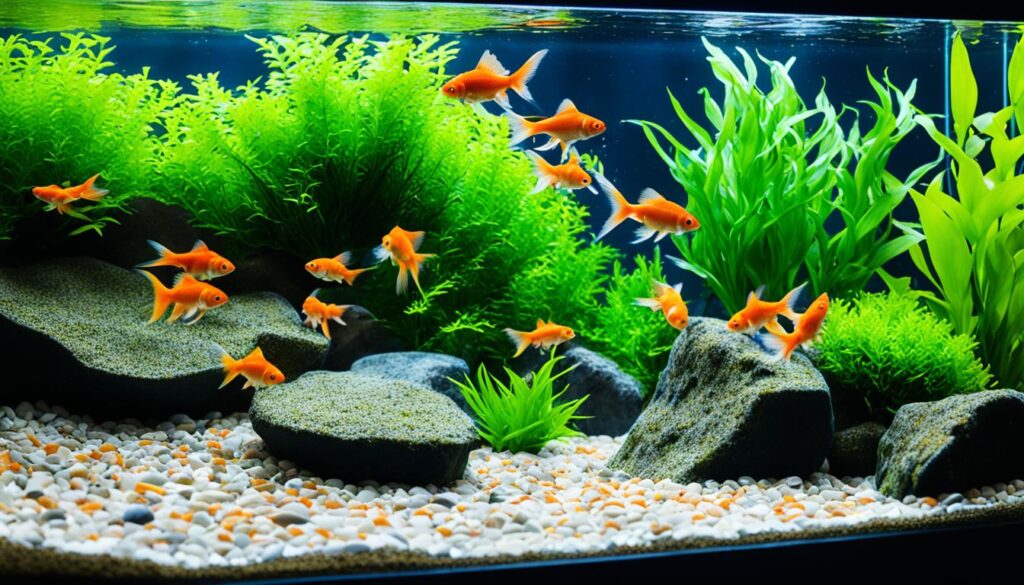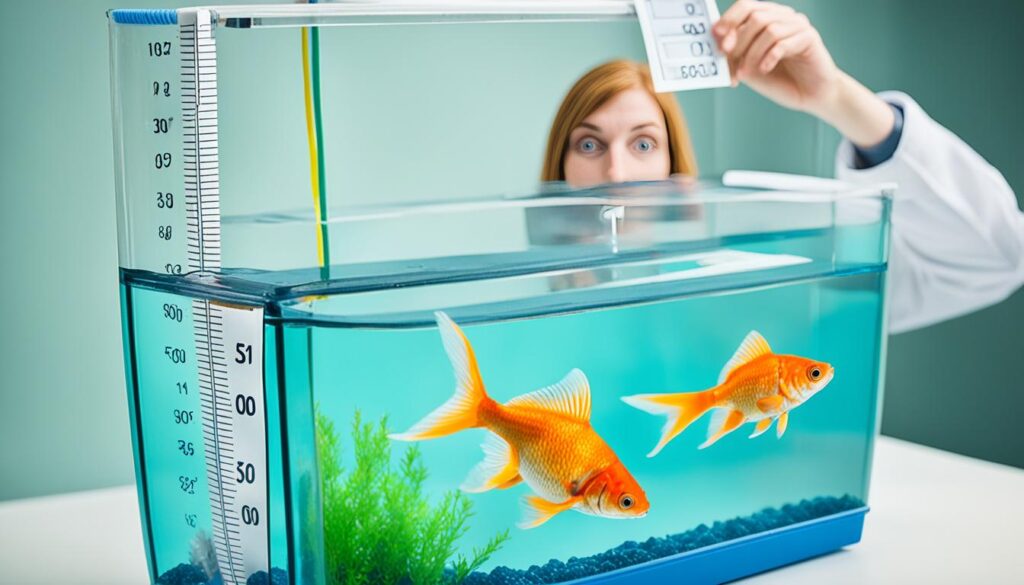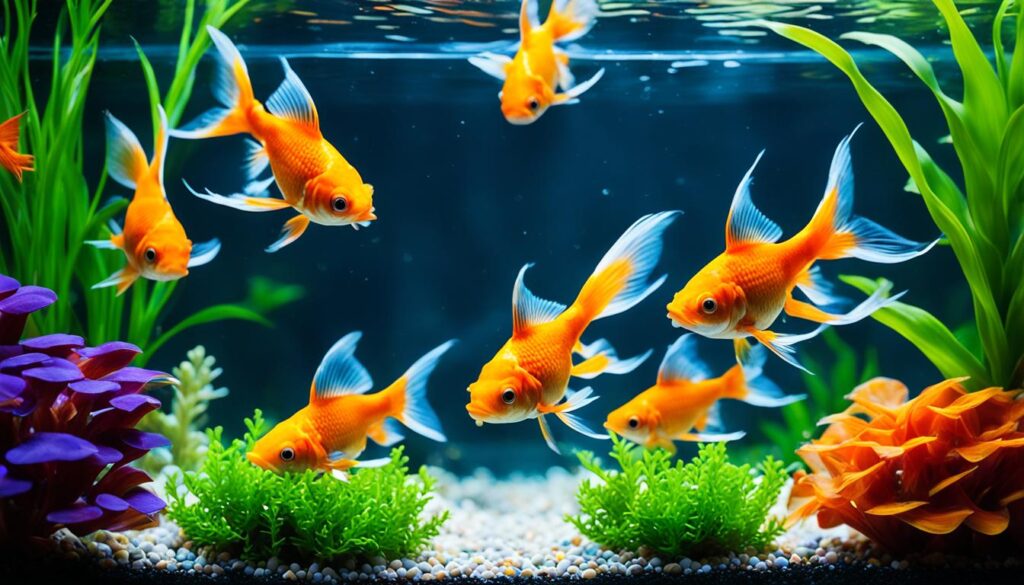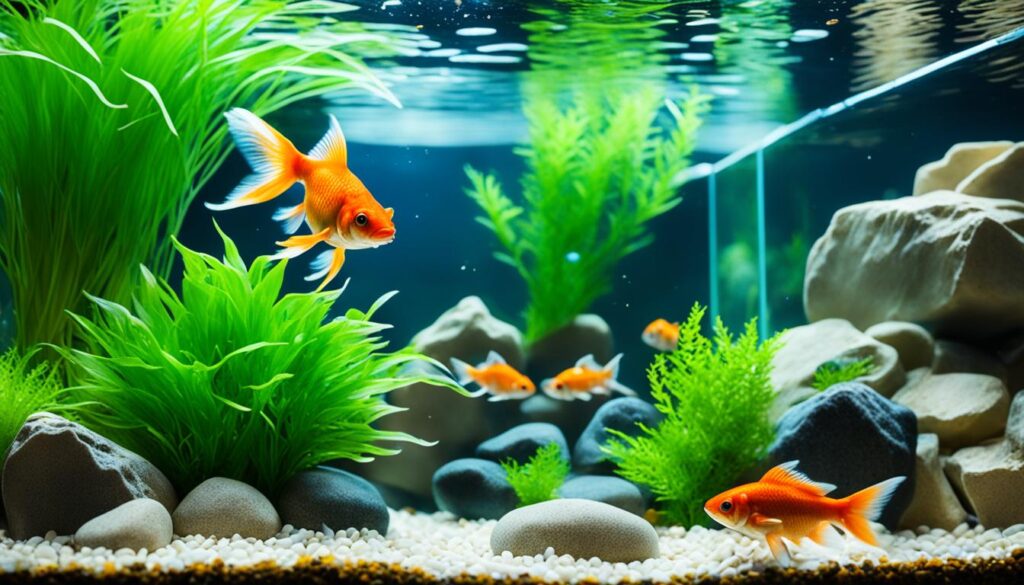Have you ever wondered if your goldfish is living in the right-sized tank? Does it have enough space to grow, swim freely, and thrive? Well, the answer might surprise you. Contrary to popular belief, goldfish actually require much larger tanks than many people think. But how do you determine the optimal tank size for your goldfish? And why is it so important? Let’s dive in and explore the answers to these questions and more.
When it comes to providing the best living conditions for your goldfish, tank size plays a critical role. In this comprehensive guide, I’ll walk you through why tank size matters, the recommended tank sizes for different types of goldfish, and how to calculate the perfect tank size for your finned friend. By the end of this article, you’ll have all the knowledge you need to create a comfortable and thriving environment for your goldfish.
Key Takeaways:
- Choosing the right tank size is essential for the growth and health of your goldfish.
- Goldfish produce a significant amount of waste, making adequate tank size crucial for water cleanliness.
- Recommended tank sizes vary depending on the type of goldfish, with larger tanks always being better.
- Signs that your goldfish needs a bigger tank include swimming difficulties and physical symptoms.
- A small tank can have serious consequences for the well-being of your goldfish.
Why is Tank Size Important for Goldfish?
Tank size is crucial for goldfish for several reasons.
- Ample Space for Growth: Goldfish have the potential to grow quite large, and they need enough space to swim and move around. A small tank can restrict their movements, leading to stunted growth and physical deformities. It is essential to provide a spacious tank that allows goldfish to reach their full size potential.
- Water Quality and Filtration: Goldfish produce a significant amount of waste, and a larger tank provides better filtration and water quality maintenance. In a small tank, waste can accumulate quickly, leading to poor water conditions and potential health issues for the fish. A larger tank with efficient filtration systems allows for proper waste removal and helps maintain a healthier environment.
To ensure the health and well-being of goldfish, it is crucial to choose a tank that accommodates their size and needs.
Recommended Tank Sizes for Goldfish
When it comes to providing the perfect home for your goldfish, tank size plays a crucial role. The right tank size ensures that your goldfish can swim and thrive comfortably, without compromising their health and well-being. Here, I will outline the recommended tank sizes for different types of goldfish.
Common Goldfish
If you have common goldfish, such as comets or shubunkins, it is recommended to provide them with a tank that is at least 30 gallons and 4 feet long. This allows enough space for them to swim and grow. As a general rule, each additional common goldfish should have an additional 12 gallons of tank capacity to ensure they have enough room to thrive.
Fancy Goldfish
Fancy goldfish, with their unique body shapes and features, require a slightly smaller tank compared to common goldfish. A minimum tank size of 20 gallons that is at least 3 feet long is suitable for fancy goldfish. It is important to note that fancy goldfish are more delicate and prone to swim bladder issues, so providing them with a spacious environment is crucial. Just like common goldfish, each additional fancy goldfish should have an extra 10 gallons of tank capacity.
Remember, these recommended tank sizes are the minimum guidelines for goldfish. It is always better to provide a larger tank if possible, as it offers more swimming space and improves water quality.

Creating an optimal environment for your goldfish starts with providing them with the right tank size. In the next section, we will explore the signs that indicate your goldfish may need a bigger tank. By understanding these signs, you can ensure that your goldfish always has a comfortable and spacious home to thrive in.
Signs that Your Goldfish Needs a Bigger Tank
Monitoring your goldfish for signs that they may need a bigger tank is crucial for their well-being. Here are some indications that the current tank size is too small:
- Fish bumping into each other or decorations while swimming: Limited space can lead to overcrowding, causing your goldfish to collide with each other or decorations within the tank.
- Lethargy and inactivity: If your goldfish appears sluggish and lacks the energy to swim around, it may be a sign that the current tank size is restricting their movement.
- Loss of appetite and foraging behavior: Goldfish that are cramped in a small tank may lose their appetite or exhibit increased foraging behavior as a result of stress.
- Development of ulcers, ragged fins, or reddened skin: Inadequate space and poor water conditions in a small tank can lead to physical ailments such as ulcers, torn fins, or skin discoloration.
If you observe any of these signs, it is essential to consider upgrading to a larger tank. Providing your goldfish with a spacious environment will enhance their mobility and overall health.
Consequences of a Small Tank for Goldfish
Keeping goldfish in a small tank can have severe consequences for their health and well-being. The negative effects of a small tank on goldfish health are numerous and should be considered when choosing an appropriate tank size.
Poor Water Quality and Stress
A small tank often means inadequate filtration and limited space, leading to poor water quality and increased stress for goldfish. Inadequate filtration cannot effectively remove waste products, such as ammonia and nitrates, which can build up and harm the fish. Stress caused by cramped conditions makes goldfish more susceptible to diseases and weakens their immune systems.
Stunted Growth and Deformities
Goldfish have the potential to grow quite large, some even reaching lengths of over a foot. In a small tank, their growth can be stunted, resulting in deformed bodies and organs. Without enough swimming space and exercise, goldfish may develop physical abnormalities, such as bent spines or misshapen fins.
Aggressive Behavior and Limited Swimming Space
Overcrowding in small tanks can lead to aggressive behavior among goldfish, as they compete for limited resources and space. Aggression can cause injuries and stress, further compromising the health and well-being of the fish. Limited swimming space restricts their natural behavior and can lead to boredom and lethargy.
Comparison of Tank Sizes
| Goldfish Type | Recommended Tank Size |
|---|---|
| Common Goldfish | At least 30 gallons and 4 feet long |
| Fancy Goldfish | Minimum 20 gallons and 3 feet long |
Providing goldfish with a tank that meets their size and social needs is essential to ensure their long-term health and happiness. A properly sized tank with adequate filtration and swimming space minimizes stress, promotes healthy growth and development, and reduces the risk of diseases. By prioritizing the well-being of your goldfish and providing them with an appropriate tank size, you can enjoy their companionship for years to come.

How to Calculate the Optimal Tank Size for Your Goldfish
Calculating the optimal tank size for your goldfish is relatively easy. To determine the right tank size for your goldfish, follow these simple steps:
- Measure the dimensions: Measure the length, width, and depth of your current tank using a measuring tape. Write down the measurements in inches or centimeters.
- Convert to gallons: Use a tank size calculator, which can be found online, to convert the dimensions into gallons. Input the measurements of your tank, and the calculator will give you the volume in gallons.
- Consider the number of goldfish: The general rule of thumb is to provide at least 10 gallons of water per goldfish. If you have multiple goldfish, add additional tank capacity for each fish.
- Ensure swimming space and oxygen exchange: It’s important to consider the dimensions of the tank to provide enough swimming space and surface area for oxygen exchange. Goldfish need enough room to swim and access oxygen from the water.
- Upgrade if necessary: If your current tank is too small to meet the calculated capacity, it is recommended to upgrade to a larger tank that can accommodate the needs of your goldfish.
By following these steps, you can determine the optimal tank size for your goldfish and provide them with a spacious and comfortable environment to thrive in.
| Type of Goldfish | Minimum Tank Size | Additional Capacity per Fish |
|---|---|---|
| Common Goldfish | 30 gallons | 12 gallons |
| Fancy Goldfish | 20 gallons | 10 gallons |
Table: Recommended tank sizes for different types of goldfish
It is important to note that these tank sizes are the minimum recommended sizes. Larger tanks are always better for goldfish, as they provide more swimming space and room for natural behaviors.

Benefits of a Properly Sized Tank for Goldfish
Providing a properly sized tank for your goldfish offers numerous benefits. A larger tank allows for better water quality maintenance, reducing the accumulation of toxic waste products and minimizing the risk of health issues for the fish. Ample swimming space promotes healthy growth and reduces stress, leading to happier and more vibrant goldfish.

Additionally, a larger tank provides opportunities for enrichment, such as adding decorations, plants, and hiding places, which can enhance the physical and mental well-being of the fish. Goldfish are naturally curious and active creatures, and having a spacious tank allows them to explore and engage in natural behaviors.
“A well-sized tank creates a comfortable and stimulating environment for goldfish to thrive.”
Moreover, a properly sized tank reduces the risk of territorial disputes among multiple goldfish. By providing adequate space, it allows each fish to establish its territory and reduces aggression, ensuring a harmonious living environment.
Advantages of a Larger Tank:
- Improved water quality: Larger tanks provide better filtration and allow for more efficient removal of waste products, ensuring cleaner and healthier water for your goldfish.
- Promotes healthy growth: Ample swimming space and freedom of movement allow goldfish to grow to their full potential, with proper body proportions.
- Reduces stress: Goldfish are less likely to become stressed in a properly sized tank, leading to a happier, more relaxed demeanor.
- Enhances natural behaviors: A larger tank allows goldfish to exhibit natural behaviors such as exploring, foraging, and hiding, which contributes to their overall well-being.
- Reduces the risk of diseases: Good water quality and reduced stress levels help goldfish maintain a strong immune system, preventing the onset of diseases.
A properly sized tank not only meets the physical needs of your goldfish but also provides an aesthetically pleasing display for you to enjoy. With the right tank size, your goldfish can thrive and flourish, showcasing their vibrant colors and engaging personalities.
Tips for Creating a Happy and Healthy Goldfish Tank
To ensure a happy and healthy goldfish tank, here are some valuable tips:
- Choose a tank size that meets the recommended capacity for your goldfish type. Goldfish need ample space to swim and grow, so providing them with a suitable tank size is essential for their well-being.
- Provide adequate filtration to maintain water quality and oxygenation in the tank. A good filtration system will help keep the water clean and free from harmful substances that can negatively impact your goldfish’s health.
- Decorate the tank with appropriate decorations, plants, and hiding places. Goldfish enjoy having a stimulating environment with plenty of hiding spots and things to explore. Adding plants and decorations also creates a more natural and aesthetically pleasing habitat for your goldfish.
- Maintain a regular cleaning and maintenance routine. This includes performing partial water changes and cleaning the filter media regularly to keep the tank environment healthy and balanced. Adequate maintenance will prevent the buildup of waste and harmful substances, ensuring a safe and clean environment for your goldfish.
- Feed your goldfish a balanced diet and avoid overfeeding. Overfeeding can lead to excess waste in the tank, compromising water quality. Follow the recommended feeding guidelines for your goldfish species and monitor their eating habits to ensure they receive the appropriate amount of food.
- Monitor the behavior and health of your goldfish regularly. Pay attention to any changes in their activity level, appetite, or physical appearance. If you notice any signs of illness or distress, take appropriate action promptly to address and resolve the issue.
By following these tips, you can create a suitable environment for your goldfish, promoting their overall health and happiness.

Remember, providing the right tank size and maintaining a healthy environment is crucial for the well-being of your goldfish.
Conclusion
Ensuring the optimal tank size for your goldfish is crucial for their overall health and well-being. Goldfish have the potential to grow quite large and produce a significant amount of waste, requiring spacious tanks with proper filtration systems. Inadequate tank size can lead to stunted growth, physical deformities, poor water quality, and increased stress for the fish.
By providing a suitable tank size, you create an environment that promotes healthy growth, reduces the risk of diseases, and enhances the overall happiness and vitality of your goldfish. Investing in the proper tank size is not only important for the well-being of your goldfish, but it also ensures that you can enjoy them for years to come.
Remember to consider the recommended tank sizes for different types of goldfish and to monitor your goldfish for signs that they may need a bigger tank. Providing a comfortable and spacious tank will help your goldfish thrive and live their best lives. Don’t underestimate the impact of tank size – it plays a crucial role in the overall health and happiness of your beloved goldfish.
FAQ
Why is tank size important for goldfish?
Tank size is important for goldfish because they have the potential to grow quite large and need ample space to swim and move around. Inadequate tank size can result in stunted growth and physical deformities. Additionally, goldfish produce a significant amount of waste, and a larger tank allows for better filtration and water quality maintenance.
What are the recommended tank sizes for goldfish?
The recommended tank size for common goldfish, such as comets and shubunkins, is at least 30 gallons and 4 feet long. Each additional fish should have an extra 12 gallons of tank capacity. Fancy goldfish, with their unique body shapes, require a minimum of a 20-gallon tank that is at least 3 feet long. Each additional fancy goldfish should have an extra 10 gallons of tank capacity.
How can I determine if my goldfish needs a bigger tank?
Signs that your goldfish may need a bigger tank include fish bumping into each other or decorations while swimming, lethargy and inactivity, loss of appetite and foraging behavior, and the development of ulcers, ragged fins, or reddened skin. These signs can indicate poor water conditions and inadequate space for the fish to thrive.
What are the consequences of keeping goldfish in a small tank?
Keeping goldfish in a small tank can lead to poor water quality due to inadequate filtration and limited space, resulting in stress, weakened immune systems, and increased susceptibility to diseases. Stunted growth, physical deformities, aggressive behavior, and limited swimming space are also common in goldfish kept in small tanks.
How can I calculate the optimal tank size for my goldfish?
To calculate the optimal tank size for your goldfish, measure the length, width, and depth of your current tank and use a tank size calculator to determine its volume in gallons. The general rule of thumb is to provide at least 10 gallons of water per goldfish, with additional capacity for each additional fish.
What are the benefits of providing a properly sized tank for goldfish?
Providing a properly sized tank for goldfish ensures better water quality maintenance, reduces the accumulation of waste products, promotes healthy growth, reduces stress, and enhances the overall happiness and vitality of the fish. A larger tank also provides opportunities for enrichment, such as adding decorations and plants, which can enhance the physical and mental well-being of the fish.
What tips can you provide for creating a happy and healthy goldfish tank?
Some tips for creating a happy and healthy goldfish tank include choosing a tank size that meets the recommended capacity for your goldfish type, providing adequate filtration, decorating the tank with appropriate decorations and hiding places, maintaining a regular cleaning and maintenance routine, feeding a balanced diet, and monitoring the behavior and health of your goldfish regularly.
What is the importance of having a properly sized tank for goldfish?
Having a properly sized tank for goldfish is important for their overall health and well-being. Inadequate tank size can result in poor water quality, stunted growth, physical deformities, and increased stress for the fish. By investing in the proper tank size, you create an environment that promotes healthy growth, reduces the risk of diseases, and enhances the overall happiness and vitality of your goldfish.
